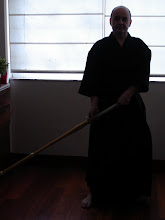Chiburi:
cleansing of the blade. Chiburi also has a spiritual meaning of cleaning one’s
soul.
Iaito – literally sword for iai, practice sword – unsharpened, typically made of alloy.
Jo-ha-kyu – the rhythm within a kata as slow-to-fast-to-slow movement.
Kesa-giri – the diagonal cut that follows the keiko-gi line. Named after the kesa/lapel that monks wore.
Keito – holding the sword at the hip while in attention.
Ki-ken-tai-itchi - Ki is spirit, ken refers to the sword, and tai refers to body. Spirit, sword, and body as one.
Kiri-oroshi - cutting down. Usually it is a 2-handed cut down from over the head.
Kokyuu - The act of inhaling and exhaling.
Metsuke – one’s gaze or look.
Mono-uchi - The “cutting” part of the sword.
Notto – returning the sword to the sheath or saya.
Nukitsuke - the cut made, in one continuous motion, from drawing the sword.
Obi – the belt wrapped around the waist/keiko-gi, in which the sword is placed.
Seitei – basic, fundamental. Seitei Gata is fundamental techniques kata.
Seiza – formal kneeling/sitting position.
Shibori – the wringing motion of one’s hands when performing a cut.
Shinken – literally “live sword” – used to describe sharp swords made in the Japanese style.
Tate-hiza – raised-knee position when kneeling/sitting.
Teito – holding the sword loose by the left side.
Torei - bow to the sword.
Zanshin – remaining spirit/heart.
Za rei – kneeling bow.
Iaito – literally sword for iai, practice sword – unsharpened, typically made of alloy.
Jo-ha-kyu – the rhythm within a kata as slow-to-fast-to-slow movement.
Kesa-giri – the diagonal cut that follows the keiko-gi line. Named after the kesa/lapel that monks wore.
Keito – holding the sword at the hip while in attention.
Ki-ken-tai-itchi - Ki is spirit, ken refers to the sword, and tai refers to body. Spirit, sword, and body as one.
Kiri-oroshi - cutting down. Usually it is a 2-handed cut down from over the head.
Kokyuu - The act of inhaling and exhaling.
Metsuke – one’s gaze or look.
Mono-uchi - The “cutting” part of the sword.
Notto – returning the sword to the sheath or saya.
Nukitsuke - the cut made, in one continuous motion, from drawing the sword.
Obi – the belt wrapped around the waist/keiko-gi, in which the sword is placed.
Seitei – basic, fundamental. Seitei Gata is fundamental techniques kata.
Seiza – formal kneeling/sitting position.
Shibori – the wringing motion of one’s hands when performing a cut.
Shinken – literally “live sword” – used to describe sharp swords made in the Japanese style.
Tate-hiza – raised-knee position when kneeling/sitting.
Teito – holding the sword loose by the left side.
Torei - bow to the sword.
Zanshin – remaining spirit/heart.
Za rei – kneeling bow.




No hay comentarios:
Publicar un comentario